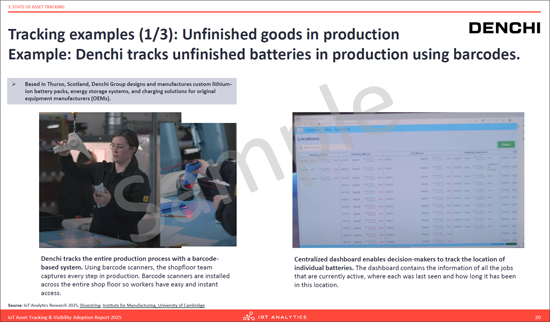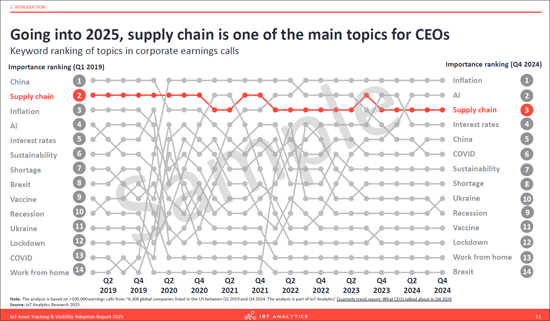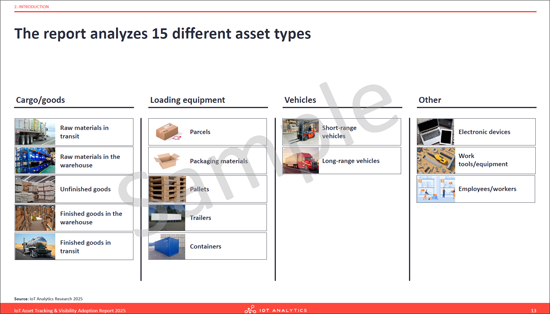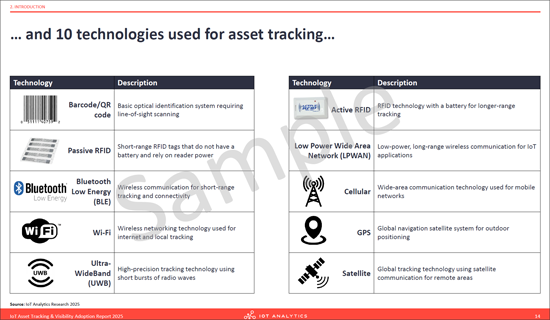|
市场调查报告书
商品编码
1697452
物联网资产追踪与可视性:采用报告(2025 年)IoT Asset Tracking & Visibility Adoption Report 2025 |
|||||||
本报告是 IoT Analytics 正在进行的系列研究报告的一部分,基于对製造、零售和建筑领域采用资产追踪解决方案的 100 家公司的广泛调查。
本报告是 IoT Analytics 发布的一份以数据为中心的市场研究报告。我们调查基于物联网的资产追踪和视觉化解决方案的实际采用情况。基于对 100 名决策者的调查,该研究探讨了企业如何使用 GPS、RFID 和物联网感测器等技术来追踪实体资产。它揭示了各行业的采用水准、追踪的资产类型、供应商参与度和支出模式,为高阶主管和策略家提供全面的基准参考点。
范例视图


范例视图


问题解答:
- 最常被追踪的资产有哪些?每项资产的追踪内容是什么?
- 资产追踪解决方案支援哪些用例?
- 最常用的追踪技术有哪些?追踪解决方案与哪些企业系统整合?
- 实施的解决方案具有哪些可扩充性/整合功能?资料是如何传输/分析的?
- 最受欢迎的供应商有哪些?他们的客户满意度如何?
- 市场上各供应商的优势和劣势是什么?
- 公司如何选择资产追踪解决方案?
- 在实施过程中您遇到了哪些课题?成功实施的关键是什么?
- 公司从实施中获得了哪些投资报酬?其投资回报是否达到了预期?
- 预计 2025 年会出现哪些发展?
特色公司
|
|
|
|
目录
第 1 章执行摘要
第 2 章简介
第3章:资产追踪的现况
- 1. 概述与要点
- 2.资产追踪概述
- 3.製药和食品饮料产业资产追踪的推动因素:冷链
- 4.追踪的资产类型
- 5.追踪范例:正在进行的工作
- 6.追踪范例:员工/工作者
- 7.追踪范例:包裹
- 8.追踪的资产数量
- 9. 追踪资产属性
- 10. 温度跟踪
- 11. 使用情形追踪
- 12.资产追踪用例:总体
- 13.资产追踪用例:按资产类型
- 14.按地区和公司规模划分的资产追踪用例
- 15.资产追踪用例:按行业
第4章 技术洞察
- 1. 概述与要点
- 2.连接技术:概述
- 3.按资产类型划分的连结技术
- 4.追踪货柜:赫伯罗特结合使用卫星和行动电话技术
- 5. 支援资产追踪的软体和平台:概述
- 6. 支援以资产类型追踪资产的软体和平台
- 7. 平台范例:与 SAP ERP 集成
- 8. 平台范例:Oracle 的 EAM 资产管理解决方案
- 9. 平台范例:Verizon 的车队管理解决方案 Connect Reveal
- 10.技术亮点:概述
- 11.技术深入分析:资产追踪解决方案的可扩展性
- 12.技术深度探究:与企业系统集成
- 13.整合影响追踪专案的成功
- 14.技术细节:资料传输频率
- 15.资料传输频率影响追踪项目的成功
- 16.技术深度探讨:资产追踪资料的迫切性分析
第5章 供应商洞察
- 1. 概述与要点
- 2.十大最常提及的资产追踪供应商:概述
- 3.十大最常被提及的资产追踪供应商:满意度与期望
- 4. Asset Tracked 提及次数最多的 10 大资产追踪供应商
- 5.与受访者有业务往来的所有供应商的详细清单。
- 6. 主要供应商提供的连接技术和硬体产品
- 7. 概述:供应商的优点和缺点
- 8.深入挖掘:供应商优势
- 9.深入挖掘:供应商弱点
- 10. 意见挖掘:供应商:SAP、内部、Oracle
- 11. 意见摘要:供应商:IBM、Microsoft、Honeywell、Zebra、Samsara
- 12. 意见摘要:供应商:Verizon、Project44、Asset Panda
第6章 推动因素、成功因素与课题
- 1. 概述与要点
- 2. 概述:资产追踪实施的推动因素与决策标准
- 3.资产追踪解决方案的关键决策标准:按地区、产业和公司规模
- 4.资产追踪解决方案的关键决策标准:按产业垂直细分
- 5.决策标准详情:概述
- 6.范例:资产追踪解决方案的成本
- 7.范例:将资料合併到现有系统中
- 8.决策标准详情:依地区、产业及规模
- 9.深入了解决策标准:详细的行业特定
- 10.实施资产追踪解决方案的目标:概述
- 11. 实施资产追踪解决方案的目的:依产业详细说明
- 12.范例:某公司如何达成其资产追踪目标
- 13.实施资产追踪的课题:概述
- 14.实施资产追踪的课题:XX
- 15.2025 年的费用、投资报酬率和业务展望:概述和要点
- 16.资产追踪费用:概述
- 17.资产追踪费用:依资产类型
- 18.资产追踪支出:详细产业垂直
- 19. 资产追踪解决方案的投资报酬率:概述
- 20. 资产追踪解决方案的投资报酬率(按细分市场和追踪资产)
- 21.为什么资产追踪解决方案具有高投资报酬率
第 7 章 支出、投资报酬率与 2025 年业务展望
- 1. 资产追踪实施结果:概述
- 2. 资产追踪实施结果:按细分市场与资产类型
- 3. 资产追踪实施结果:按资产类型细分的详细信息
- 4. 2025年支出展望:概述
- 5.2025 年支出展望:详细的行业细分信息
- 6. 2025 年按资产类型划分的支出展望
- 7.支出成长的五大推动因素(基于受访者的评论)
- 8.支出增加的原因
第 8 章 研究方法
第 9 章附录
第 10 章 关于物联网分析
A 142-page report on enterprise asset-tracking projects in manufacturing, mfg. supply chains, construction, retail, energy, incl. insights on implementation, vendors in use, spending patterns, ROI, challenges, and success factors.
The "IoT Asset Tracking & Visibility Adoption Report 2025" is part of IoT Analytics' ongoing coverage of the IoT in general. The information presented in this report is based on an extensive survey of 100 adopters of asset-tracking solutions in the manufacturing, retail, and construction industries. The purpose is to inform other market participants about the current state of asset tracking across companies. Survey participants were selected randomly, and their knowledge was verified independently. To ensure complete objectivity, IoT Analytics did not alter or supplement any survey results and did not accept participants who were suggested by third parties (e.g., customers from specific vendors)-and where it's heading.
SAMPLE VIEW


Understand the current state of IoT asset tracking adoption
The "IoT Asset Tracking & Visibility Adoption Report 2025" is a data-centric market research publication by IoT Analytics. It explores the real-world adoption of IoT-based asset tracking and visibility solutions. Based on a global survey of 100 qualified decision-makers, the report investigates how companies track physical assets using technologies like GPS, RFID, and IoT sensors. It highlights adoption levels, tracked asset types, vendor involvement, and spending patterns across industries, offering C-level executives and strategists a comprehensive reference point for benchmarking.
SAMPLE VIEW


Structured analysis across key areas of asset tracking
The report is organized into clearly defined chapters, each covering a specific aspect of IoT-based asset tracking and visibility adoption:
- Executive summary. Highlights of the key findings and conclusions from the survey analysis.
- Introduction. Context and definitions, including the scope of asset types, environments, and visibility goals.
- State of asset tracking. Examines which assets are tracked, how many, which attributes are monitored, and the implementation footprint across use cases.
- Technology insights. Reviews tagging technologies, connectivity protocols, software platforms, integration levels, and data transmission frequency.
- Vendor insights. Details which solution providers are used, customer satisfaction levels, and vendor strengths/weaknesses.
- Drivers, success factors & challenges. Covers project goals, implementation bottlenecks, and best practices.
- Spending, ROI & business outlook 2025. Discusses current and planned investment levels, ROI findings, and future expectations.
- Methodology and appendix. Outlines survey methodology, respondent demographics, and additional charts.
Insights into what companies are doing in the field
The report provides a detailed snapshot of how companies are applying IoT-based asset tracking today. Based on end-user input, it allows market participants to understand what is being tracked, how it is being tracked, and why:
- Asset types and tracked data. Understand which assets are being monitored and what attributes-like location, temperature, or vibration-are tracked by end-users.
- Scale of deployment. See how many assets are currently tracked per type and what share of total assets companies aim to monitor in full rollouts.
- Technology and integration. Learn which connectivity technologies and sensor types are used in practice, how often data is transmitted, and how tracking systems are integrated into enterprise platforms like ERP or inventory management.
- Software and use cases. Discover which software platforms support tracking and what use cases-such as theft prevention, predictive maintenance, or inventory optimization-are actively enabled by users.
- Vendor landscape. Identify which solution providers are being used, what parts of the solution they deliver, and how satisfied users are with their performance.
- Spending and ROI. Benchmark how much companies are spending annually, how budgets are expected to change in 2025, and what levels of ROI are achieved across asset types.
- Implementation realities. Gain insight into how end-users select solutions, handle time-sensitive data, overcome deployment challenges, and what they cite as key success factors.
A downloadable sample of the report is available to preview the structure, explore example insights, and assess the data depth. It provides a grounded foundation for organizations looking to benchmark or plan their IoT asset tracking initiatives.
Questions answered:
- Which are the most tracked assets and what is being tracked for each asset?
- Which use cases are enabled from asset-tracking solutions?
- Which are the most used tracking technologies, and which company systems are integrated with the tracking solution?
- How scalable/integrated are the implemented solutions, and how is the data transmitted/analyzed?
- Which are the most used vendors, and how satisfied are their customers?
- What are the strengths and weaknesses of individual vendors in the market?
- How are adopters selecting asset-tracking solutions?
- What challenges did they face when implementing, and what tips do they have for a successful implementation?
- What ROI have companies seen from their implementations, and how did this meet their expectations?
- How much are companies spending on asset tracking and how is that spending expected to develop in 2025?
Companies mentioned:
A selection of companies mentioned in the report.
|
|
|
|
Table of Contents
1. Executive Summary
2. Introduction
- 1. What is Asset Tracking in the context of this report
- 2. Asset tracking plays a crucial role in companies' supply chains
- 3. Going into 2025, supply chain is one of the main topics for CEOs
- 4. The interest in search terms related to asset tracking and supply chain is slowly growing
- 5. Companies with a focus on asset tracking are seeing the results of that interest
- 6. There are many reasons why companies adopt IoT asset-tracking solutions
- 7. The report is segmented into 5 chapters
- 8. The report analyzes 15 different asset types
- 9. ... and 10 technologies used for asset tracking...
- 10. ... based on a survey of 100 end-users of asset-tracking solutions
- 11. Examples of companies who participated in the research
3. State of asset tracking
- 1. Chapter 3: State of asset tracking - Overview and key takeaways
- 2. Asset tracking overview
- 3. What is driving asset tracking in the Pharma and F&B industries: Cold chains
- 4. Types of assets tracked
- 5. Tracking examples: Unfinished goods in production - Example: Denchi tracks unfinished batteries in production using barcodes.
- 6. Tracking examples: Employees/workers - Example: Salco tracks workers using a UWB solution.
- 7. Tracking examples: Parcels - Example: Altru tracks parcels using Bluetooth-enabled sensors.
- 8. Number of assets tracked
- 9. Asset attributes tracked
- 10. Tracking temperature: Sensitech provides a platform to see asset temperature over time and accepted ranges
- 11. Tracking Utilization: Samsara provides special "Utilization Reports" that show how often assets are used
- 12. Asset tracking use cases: Overall
- 13. Asset tracking use cases: By asset type
- 14. Asset tracking use cases: By region, and company size
- 15. Asset tracking use cases: By industry
4. Technology insights
- 1. Chapter 4: Technology insights - Overview and key takeaways
- 2. Connectivity technologies: Overview
- 3. Connectivity technologies: By asset type
- 4. Tracking shipping containers: Hapag Lloyd uses a mix of satellite and cellular technologies
- 5. Software and platforms that support asset tracking: Overview
- 6. Software and platforms that support asset tracking: By asset type
- 7. Platform example: Integrating into SAP ERP
- 8. Platform example: Oracle's EAM Asset Management solution
- 9. Platform example: Verizon's Fleet Management solution "Verizon Connect Reveal"
- 10. Technology highlights: Overview
- 11. Technology deep-dive: Scalability of asset-tracking solutions
- 12. Technology deep-dive: Integration with company systems
- 13. Integration affecting success of tracking projects
- 14. Technology deep-dive: Data transmission frequency
- 15. Data transmission frequency affecting success of tracking projects
- 16. Technology deep-dive: Analysis urgency of asset tracking data
5. Vendor insights
- 1. Chapter 5: Vendor insights - Overview and key takeaways
- 2. 10 most mentioned asset-tracking vendors: Overview
- 3. 10 most mentioned asset-tracking vendors: Satisfaction & expectations
- 4. 10 most mentioned asset-tracking vendors: By asset tracked
- 5. Extensive list with all vendors that respondents have worked with
- 6. Connectivity technologies and hardware offerings of select vendors
- 7. Overview: Vendor strengths and weaknesses
- 8. Opinion deep dives: Vendor strengths
- 9. Opinion deep dives: Vendor weaknesses
- 10. Opinion deep dives: By vendor: SAP, in-house, and Oracle
- 11. Opinion deep dives: By vendor: IBM, Microsoft, Honeywell, Zebra, Samsara
- 12. Opinion deep dives: By vendor: Verizon, Project44, Asset Panda
6. Drivers, success factors & challenges
- 1. Chapter 6: Drivers, success factors & challenges - Overview and key takeaways
- 2. Overview: Asset-tracking implementation drivers & decision-making criteria
- 3. Top decision-making criteria for asset-tracking solutions: By region, industry, and company size
- 4. Top decision-making criteria for asset-tracking solutions: By detailed industry
- 5. Decision-making criteria deep-dive: Overview
- 6. Example: Cost of asset-tracking solutions
- 7. Example: Incorporating data in existing systems
- 8. Decision-making criteria deep-dive: By region, industry, size
- 9. Decision-making criteria deep-dive: By detailed industry
- 10. Goals when implementing an asset-tracking solution: Overview
- 11. Goals when implementing an asset-tracking solution: By detailed industry
- 12. Examples: How specific companies achieved their asset tracking goals
- 13. Challenges when implementing asset tracking: Overview
- 14. Challenges when implementing asset tracking: XX
- 15. Chapter 7: Spending, ROI & business outlook 2025 - Overview and key takeaways
- 16. Asset-tracking spending: Overview
- 17. Asset-tracking spending: By asset type
- 18. Asset-tracking spending: By detailed industry
- 19. ROI of asset-tracking solutions: Overview
- 20. ROI of asset-tracking solutions: By segment and asset tracked
- 21. Reasons for a high ROI of an asset-tracking solution
7. Spending, ROI & business outlook 2025
- 1. Results of asset-tracking implementations: Overview
- 2. Results of asset-tracking implementations: By segment and asset type
- 3. Results of asset-tracking implementations: By asset type detailed
- 4. Spending outlook for 2025: Overview
- 5. Spending outlook for 2025: By detailed industry
- 6. Spending outlook for 2025: By asset type
- 7. 5 key drivers of higher spending (based on respondent comments)
- 8. Reasons for increased spending









